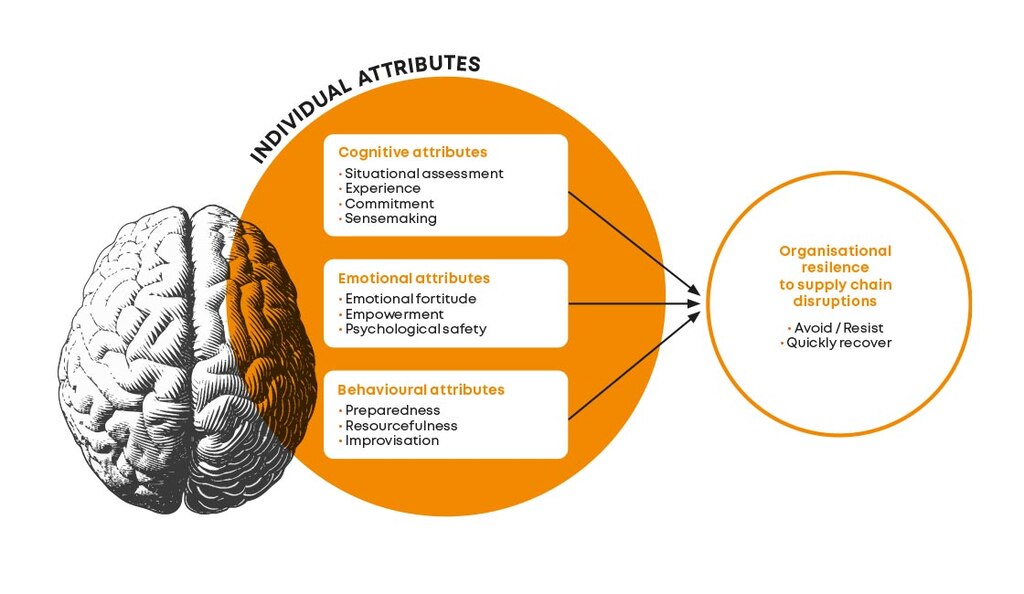
LOGISTICS RESEARCH
» Markus Gerschberger, Professor of University of Applied Sciences Upper Austria (Austria) and of Georgia Institute of Technology (US)
» Melanie Gerschberger, Assistant Professor of University of Applied Sciences Upper Austria (Austria)
» Scott C. Ellis, Professor of Georgia Southern University (US)

Organisational resilience is the critical capability that enables companies and supply chains to cope with disruptions that arise. However, there is scant research linking it to the most essential resource of any enterprise: its employees. Businesses create structures and processes to enhance their responsiveness to different scenarios. But people are the ones who make the decisions that determine the outcomes and what recovery will look like following disruptions.
A resilient organisation needs staff who can respond quickly and effectively to critical events. Therefore, we considered the following for our research: What are the important attributes that allow employees to successfully respond to supply chain disruptions? And how do these attributes contribute to organisational resilience? To answer these questions, we conducted a qualitative study from 44 interviews with workers from four different companies operating in the automotive industry. The results reveal 10 critical attributes that explain how these people contribute towards their organisations’ resilience.
Organisational resilience in the supply chain
Within the psychology domain, resilience refers to an individual’s capacity to adapt to stress and adversity. In supply chain management literature, the concept of resilience centres on how firms cope with unforeseen circumstances that hinder the normal flow of goods and materials.
For this study, we analysed various events and interviewed multiple subjects. We selected Western European manufacturing businesses operating in global automotive supply chains. In this sector, stoppages can cause significant economic losses upwards of $40,000 per hour per production line. We interviewed employees actively engaged in resolving disruptions. They represented a diverse sample in terms of experience, positions and departments. As the company names remained anonymous, we will refer to them as Firms A, B, C and D.
Findings: 10 personality attributes
Our analysis of the case-study data led to three main findings. First, organisational resilience is enhanced through employees’ cognitive abilities to quickly recognise changes in the environment and interpret ambiguous events. Second, emotional attributes play a key role in increasing a business’s resilience capability. Finally, our data revealed that behavioural attributes — i.e., preparedness, resourcefulness and improvisation — are particularly salient attributes that enable organisations to avoid, resist, or effectively recover from disruptions. These findings all point to 10 personality characteristics that foster organisational resilience:

1. Situational assessment
This cognitive process enables people to judge whether a situation could become a crisis in the near future. It involves alertness, mindfulness and a solid grasp of reality. Proactive detection of early warning signals fosters the avoidance of supply chain disruptions. Conversely, a lack of situational assessment may cause severe financial and operational losses.
This was the case of one of the firms that participated in our study. After failing to anticipate the bankruptcy of one of its suppliers, it created the position of a risk manager to identify such setbacks in advance.
2. Experience
Experience refers to the practical knowledge and skills gained from direct observation of or participation in activities and events. It facilitates improved understanding of current situations. Analysis also revealed that organisational resilience increases if senior, knowledgeable employees share their expertise with less experienced co-workers.
The logistics manager at Firm C described how knowledge accumulated through past failures helped the company avoid a potential crisis. Specifically, a taxi driver strike had blocked the roads surrounding a key supplier. Consequently, Firm C decided to pay its primary 3PL providers more than the standard rate; they reciprocated by adopting alternate routes and other solutions.
3. Commitment
This consists of identifying with one’s organisation. It is reflected in a strong belief in the business’s goals and values. The head of quality at Firm D highlighted that “commitment and loyalty are important, as they result in low turnover rates, knowledge that stays in the company for a very long time, and, ultimately, fewer errors.”
4. Sensemaking
This reflects the capacity to understand (i.e., make sense of) situations and events that are novel, surprising, ambiguous, confusing, or violate expectations. It is particularly helpful when disruptions are unprecedented and require responses that go beyond an organisation’s normal repertoire. For example, Firm D realised that the shortage of 400 missing radios would jeopardise production for nearly a week. Instead of finishing the vehicles in an extra shift, the business decided it was more cost-effective to fly in 400 radios.
5. Emotional fortitude
This refers to the ability to be aware of one’s own feelings and impulses, the factors causing them and the choice of behaviour in response to a critical situation. It is crucial for workers to control their emotions, maintain their objectivity and deliver high-level performance. Resilient employees focus on what can be controlled, view challenges as opportunities and seek creative ways to handle stressful situations.
6. Empowerment
This is generally described as a psychological state of intrinsic motivation. It is fostered when power and decision-making are shared among hierarchical unequals. Empowerment leads to higher levels of motivation, creativity and self-efficacy. Empowered employees think, behave and act autonomously, taking responsibility for their results.
7. Psychological safety
This relates to an employee’s perception that the workplace is safe for risk-taking behaviours intended to achieve superior outcomes. This attribute enables individuals to grow, learn, contribute and perform their duties without fear of being seen as incompetent when asking questions or admitting mistakes. The COO at Firm A noted: “There are no bad ideas; the only bad thing is having no idea about what to do in a critical situation. There is no time to judge others or their ideas. However, it is important that we are creative and share our ideas in order to come up with the best possible solution.”

8. Preparedness
This is the process of taking actions and making investments before they are needed. Employee preparedness can reduce the impact of a supply chain disruption and speed up the recovery process. It also allows businesses to capitalise on opportunities that they might otherwise miss.
9. Resourcefulness
This reflects the extent to which staff members engage in self-help and help-seeking behaviours to identify solutions and achieve individual and organisational targets. Help-seeking behaviours are enhanced by interpersonal relationships that promote cooperation and facilitate access to added resources. A supply chain manager at Firm B explained: “The first rule is that our employees should try to solve a problem on their own. And second, if that's not doable, reach out and seek support.”
10. Improvisation
This is the act of finding ways to make do with available resources. Whereas preparedness is learnt and highly patterned, improvisation is less routinised and requires creative, ad hoc responses. The CEO of Firm C affirmed: “Sometimes, you have to improvise, find creative solutions and fix the problem as fast as you can.” Employee improvisation can also facilitate the disruption recovery process.
Conclusions and practical advice
An organisation’s resilience can be increased by not only improving its capabilities but also leveraging its human resources. This study also offers practical insights for managers:
- Companies should invest in organisational culture that places high value on employees, their empowerment and psychological safety. This philosophy brings indirect benefits as well, such as higher talent commitment and retention.
- Our analysis reinforces the importance of worker education and training to foster critical attributes. Options include conducting role-playing or engaging in simulated disruptions in stable periods. Such exercises would also provide an opportunity to identify potential gaps in important attributes.
- Ultimately, businesses should encourage employees to try out new things, make their own decisions and learn to take responsibility for them. Furthermore, managers should invite staff members to meetings and allow them to openly speak their mind. Findings also suggest that retaining employees in times of crises increases their commitment and loyalty.
Authors of the research:
- Melanie Gerschberger, Assistant Professor of Supply Chain Management, University of Applied Sciences Upper Austria (Austria)
- Scott C. Ellis, Professor of Logistics and Supply Chain Management, Georgia Southern University (US)
- Markus Gerschberger, Markus Gerschberger, Professor of Supply Chain Management, University of Applied Sciences Upper Austria (Austria); and Affiliated Faculty, Georgia Institute of Technology (US)
Original publication: Gerschberger, Melanie, Scott C. Ellis and Markus Gerschberger. 2023. Linking Employee Attributes and Organizational Resilience: An Empirically Driven Model. Edited by Richey R. and Davis-Sramek B. (Wiley). Journal of Business Logistics 44 (3): 407-37.
This work has been funded by the programme ‘Guideline to stimulate the development/expansion of future-oriented research fields at Upper Austrian non-university research institutions 2022-2029’ by the Province of Upper Austria.
